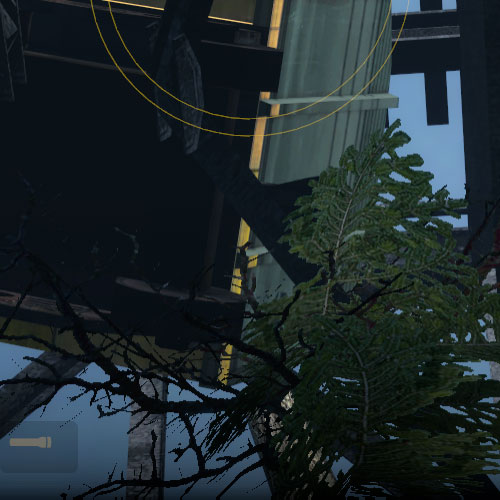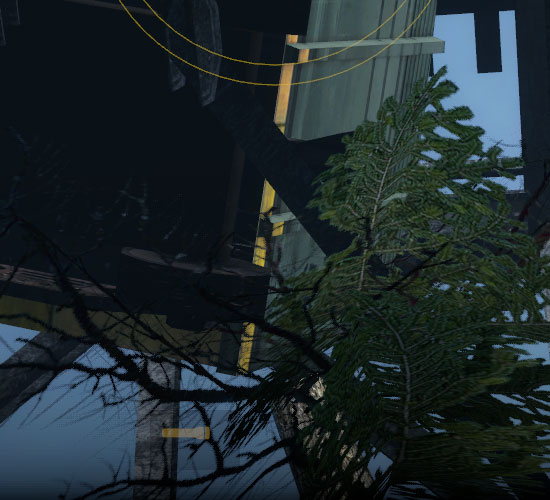AMD's Radeon HD 5870: Bringing About the Next Generation Of GPUs
by Ryan Smith on September 23, 2009 9:00 AM EST- Posted in
- GPUs
The Return of Supersample AA
Over the years, the methods used to implement anti-aliasing on video cards have bounced back and forth. The earliest generation of cards such as the 3Dfx Voodoo 4/5 and ATI and NVIDIA’s DirectX 7 parts implemented supersampling, which involved rendering a scene at a higher resolution and scaling it down for display. Using supersampling did a great job of removing aliasing while also slightly improving the overall quality of the image due to the fact that it was sampled at a higher resolution.
But supersampling was expensive, particularly on those early cards. So the next generation implemented multisampling, which instead of rendering a scene at a higher resolution, rendered it at the desired resolution and then sampled polygon edges to find and remove aliasing. The overall quality wasn’t quite as good as supersampling, but it was much faster, with that gap increasing as MSAA implementations became more refined.
Lately we have seen a slow bounce back to the other direction, as MSAA’s imperfections became more noticeable and in need of correction. Here supersampling saw a limited reintroduction, with AMD and NVIDIA using it on certain parts of a frame as part of their Adaptive Anti-Aliasing(AAA) and Supersample Transparency Anti-Aliasing(SSTr) schemes respectively. Here SSAA would be used to smooth out semi-transparent textures, where the textures themselves were the aliasing artifact and MSAA could not work on them since they were not a polygon. This still didn’t completely resolve MSAA’s shortcomings compared to SSAA, but it solved the transparent texture problem. With these technologies the difference between MSAA and SSAA were reduced to MSAA being unable to anti-alias shader output, and MSAA not having the advantages of sampling textures at a higher resolution.
With the 5800 series, things have finally come full circle for AMD. Based upon their SSAA implementation for Adaptive Anti-Aliasing, they have re-implemented SSAA as a full screen anti-aliasing mode. Now gamers can once again access the higher quality anti-aliasing offered by a pure SSAA mode, instead of being limited to the best of what MSAA + AAA could do.
Ultimately the inclusion of this feature on the 5870 comes down to two matters: the card has lots and lots of processing power to throw around, and shader aliasing was the last obstacle that MSAA + AAA could not solve. With the reintroduction of SSAA, AMD is not dropping or downplaying their existing MSAA modes; rather it’s offered as another option, particularly one geared towards use on older games.
“Older games” is an important keyword here, as there is a catch to AMD’s SSAA implementation: It only works under OpenGL and DirectX9. As we found out in our testing and after much head-scratching, it does not work on DX10 or DX11 games. Attempting to utilize it there will result in the game switching to MSAA.
When we asked AMD about this, they cited the fact that DX10 and later give developers much greater control over anti-aliasing patterns, and that using SSAA with these controls may create incompatibility problems. Furthermore the games that can best run with SSAA enabled from a performance standpoint are older titles, making the use of SSAA a more reasonable choice with older games as opposed to newer games. We’re told that AMD will “continue to investigate” implementing a proper version of SSAA for DX10+, but it’s not something we’re expecting any time soon.
Unfortunately, in our testing of AMD’s SSAA mode, there are clearly a few kinks to work out. Our first AA image quality test was going to be the railroad bridge at the beginning of Half Life 2: Episode 2. That scene is full of aliased metal bars, cars, and trees. However as we’re going to lay out in this screenshot, while AMD’s SSAA mode eliminated the aliasing, it also gave the entire image a smooth makeover – too smooth. SSAA isn’t supposed to blur things, it’s only supposed to make things smoother by removing all aliasing in geometry, shaders, and textures alike.
As it turns out this is a freshly discovered bug in their SSAA implementation that affects newer Source-engine games. Presumably we’d see something similar in the rest of The Orange Box, and possibly other HL2 games. This is an unfortunate engine to have a bug in, since Source-engine games tend to be heavily CPU limited anyhow, making them perfect candidates for SSAA. AMD is hoping to have a fix out for this bug soon.
“But wait!” you say. “Doesn’t NVIDIA have SSAA modes too? How would those do?” And indeed you would be right. While NVIDIA dropped official support for SSAA a number of years ago, it has remained as an unofficial feature that can be enabled in Direct3D games, using tools such as nHancer to set the AA mode.
Unfortunately NVIDIA’s SSAA mode isn’t even in the running here, and we’ll show you why.

5870 SSAA

GTX 280 MSAA

GTX 280 SSAA
At the top we have the view from DX9 FSAA Viewer of ATI’s 4x SSAA mode. Notice that it’s a rotated grid with 4 geometry samples (red) and 4 texture samples. Below that we have NVIDIA’s 4x MSAA mode, a rotated grid with 4 geometry samples and a single texture sample. Finally we have NVIDIA’s 4x SSAA mode, an ordered grid with 4 geometry samples and 4 texture samples. For reasons that we won’t get delve into, rotated grids are a better grid layout from a quality standpoint than ordered grids. This is why early implementations of AA using ordered grids were dropped for rotated grids, and is why no one uses ordered grids these days for MSAA.
Furthermore, when actually using NVIDIA's SSAA mode, we ran into some definite quality issues with HL2: Ep2. We're not sure if these are related to the use of an ordered grid or not, but it's a possibility we can't ignore.
If you compare the two shots, with MSAA 4x the scene is almost perfectly anti-aliased, except for some trouble along the bottom/side edge of the railcar. If we switch to SSAA 4x that aliasing is solved, but we have a new problem: all of a sudden a number of fine tree branches have gone missing. While MSAA properly anti-aliased them, SSAA anti-aliased them right out of existence.
For this reason we will not be taking a look at NVIDIA’s SSAA modes. Besides the fact that they’re unofficial in the first place, the use of a rotated grid and the problems in HL2 cement the fact that they’re not suitable for general use.












327 Comments
View All Comments
dieselcat18 - Saturday, October 3, 2009 - link
It truly amazes me that AnandTech allows a Troll like you to keep posting...but there is always one moron that comes to a forum like this and shows his a** to the world...So we all know it to be you...nice work not bringing anything resembling an intelligent discussion to the table..Oh and please don't tell me what it is that I bring to the conversation...my thoughts about this topic have nothing to do with my reply to you about your vulgar manner and lack of respect for anyone that has a difference of opinion.Oh and as for you paper launch...well sites like Newegg were sold out immediately because of the overwhelming demand for this card and I'll bet you anything there are cards available and in good supply at this very moment...Why don't you take a look and give us all another update.....I guess having that big "L" stamped on your forehead sums it up.....
SiliconDoc - Wednesday, September 23, 2009 - link
No, they didn't, because the 5870's just showed up last night, 4 of them, and just a bit ago the ONE of them actually became "available", the Powercolor brand.The other three 5870's are NOT AVAILABLE but are listed....
So "ATI paper launch" is the key idea here (for non red roosters).
1:43 PM CST, Wed. Sept. 23rd, 2009.
---
Yes, I watched them appear on the egg last night(I'm such a red fanboy I even love paper launches)... LOL
crimson117 - Wednesday, September 23, 2009 - link
Current cheapest GTX 295 at Newegg is $469.99.http://www.newegg.com/Product/Product.aspx?Item=N8...">http://www.newegg.com/Product/Product.a...p;cm_re=...
B3an - Wednesday, September 23, 2009 - link
Ryan, on your AA page, you have an example of the unofficial Nvidia SSAA where the tree branches have gone missing in HL2. And say because of this it's not suitable for general use.But for both the ATI pics, on either MSAA or SSAA, the tree branches are missing as well. Did you not notice this? because you do not comment on it.
Either way it looks like ATI AA is still worse, or there is a bug.
Ryan Smith - Wednesday, September 23, 2009 - link
We used the same save game, but not the same computer. These were separate issues we were chasing down at the same time, so they're not meant to be comparable. In this case I believe some of the shots were at 1600x1200, and others were at 1680x1050. The result of which is that the widescreen shots are effectively back a bit farther due to the use of the same FOV at all times in HL2.As you'll see in our Crysis shots, there's no difference. I can look in to this issue later however, if you'd like.
chizow - Wednesday, September 23, 2009 - link
Really enjoyed the discussion of the architecture, new features, DX11, Compute Shaders, the new AF algorithm and the reintroduction of SSAA an ATI parts.As for the card itself, its definitely impressive for a single-GPU but the muted enthusiasm in your conclusion seems justified. Its not the definite leader for single-card performance as the 295 is still consistently faster and the 5870 even fails to consistently outperform its own predecessor, the 4870X2.
Its scaling problems are really odd given its internals and overall specs seem to indicate its just RV790 CF on a single die, yet it scales worst than the previous generation in CF. I'd say you're probably onto something thinking AMD underestimated the 5870's bandwidth requirements.
Anyways, nice card and nice effort from AMD, even if its stay at the top is short-lived. AMD did a better job pricing this time around and will undoubtedly enjoy high sales volume with little competition in the coming months with Win 7's launch, up until Nvidia is able to counter with GT300.
chizow - Wednesday, September 23, 2009 - link
Holy....lolI didn't even realize til I read another comment that Ryan Smith wrote this and not Anand/Derek collaboration. That's a compliment btw, it read very Anand-esque the entire time! ;-) Really enjoyed it similar to some of your earlier efforts like the 3-part Vista memory investigation.
formulav8 - Wednesday, September 23, 2009 - link
I wouldn't be surprised if most of us already knew what was going to take place with performance and what-not. But its still a nice card whether I knew the specs before its official release or not. (And viewed many purposely leak benches). :)Jason
PJABBER - Wednesday, September 23, 2009 - link
Another fine review and nice to see it hit today. Your reviews are one reason I keep coming back to AT!Unfortunately, at MSRP the 5870 doesn't offer enough for me to move past the 4890 I am currently using, and bought for $130 during one of the sales streaks a month or so ago. Will re-evaluate when we actually start seeing price drops and/or DX11 games hit the shelves.
wicko - Wednesday, September 23, 2009 - link
It would have been nice to see 4890 in CF against 5870 in CF. 500$ spent vs 800$ spent :p